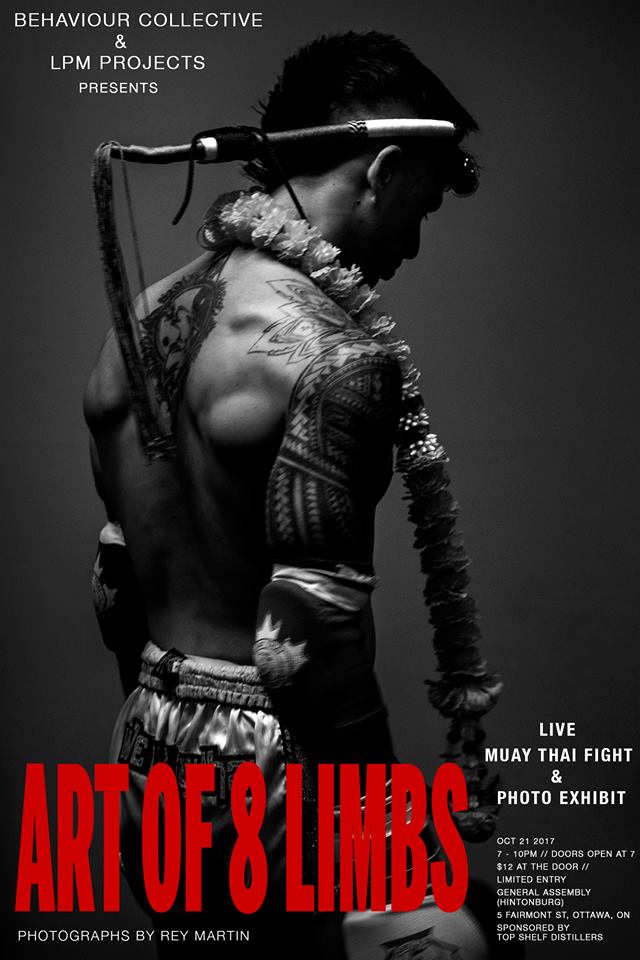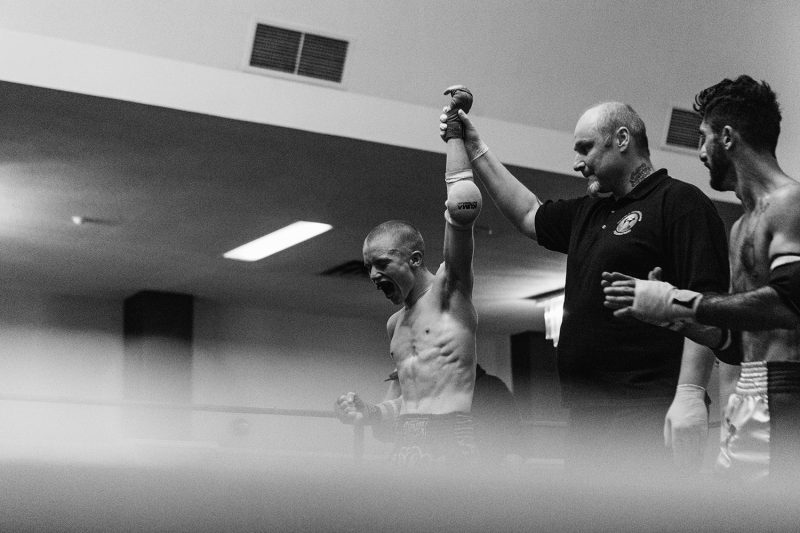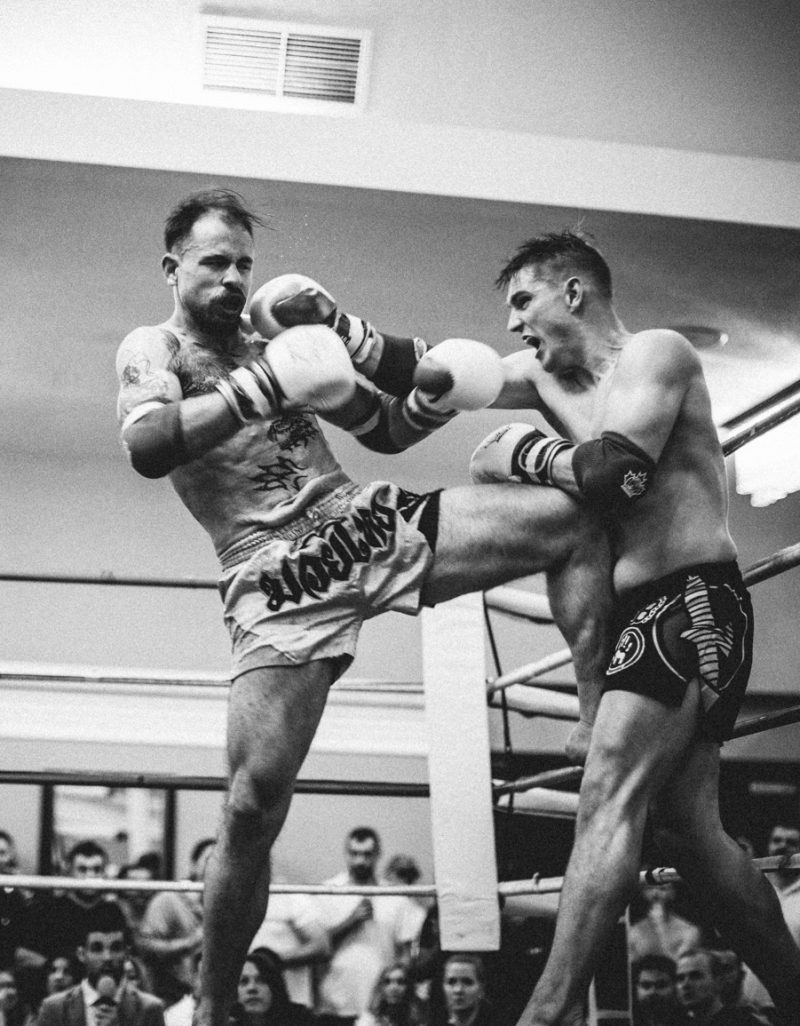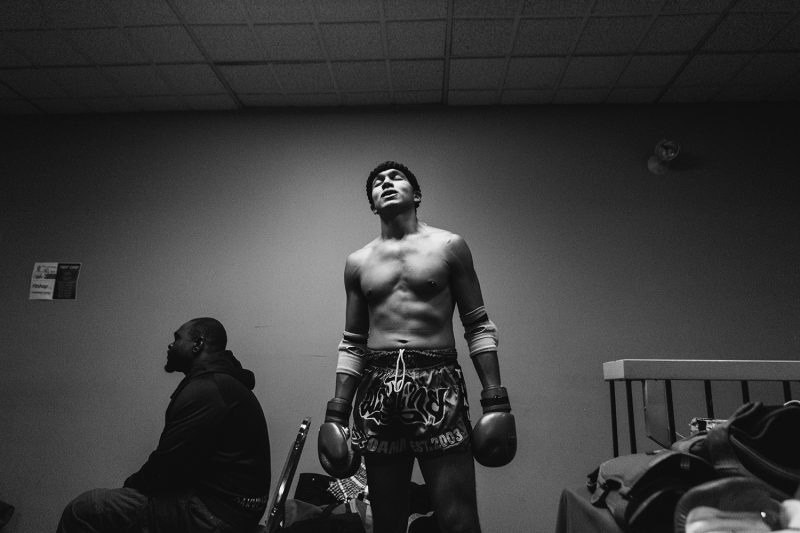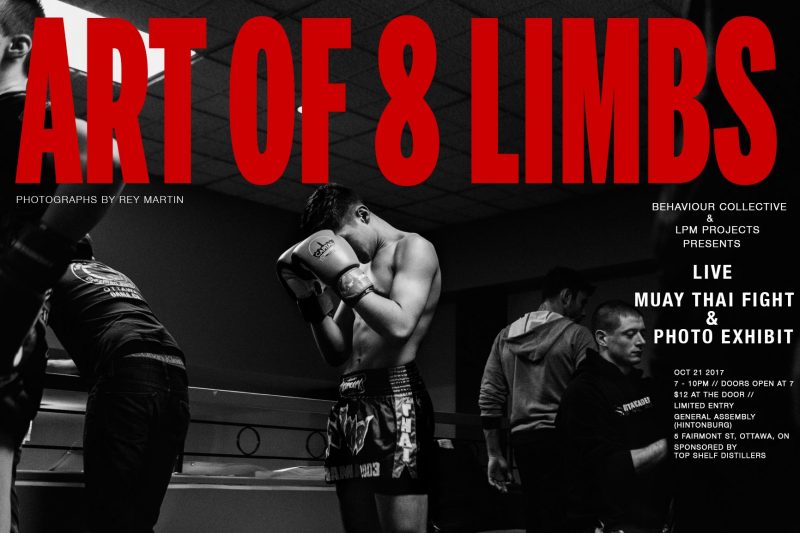Art of Eight Limbs 2017
The Art of Eight Limbs
Curated by Behaviour Collective & LPM Projects
Event Date: October 21, 2017
Time: 7 – 10 PM
Venue: General Assembly (Hintonburg)
Address: 5 Fairmont St, Ottawa, ON
Exhibit Length: 1 Day
STATEMENT
FIGHT. fight for your life. Fight or flight? Fuck that. FIGHT. Stand your ground, the sweat pour and the blood drip. You’re not just gonna stand there, you’re not like these people. So suit up for battle solider, honor your gods and march straight into your destiny. Fight for the other side. The other side waits with diamonds and pearls and one thousand virgins… They are all yours… But first you must fight.
ART OF 8 LIMBS
‘Art of 8 Limbs’ is a project by Rey Martin who documented combat fighting in Ottawa. Rey would photograph fighters before, during and after a bout with the main goal being documenting the different approaches to a contest, portraying the mental, the physical and the spiritual battle. You can teach someone how to throw a punch but you cannot teach him or her how to take one. From warfare to entertainment, the ultimate test of physicality and wit used to be endured on the battlefield as man’s oldest sport. The reasoning behind any fighter is personal. What is your reason? To provide? Is it for the freedom and thrill? For glory? Respect? It’s money, right? Or is it deeper than that. Is it for protection? Or is it revenge? Historically, Muay Thai was taught early on in childhood as a means of discipline, teaching manners and self-defense. It was a way to train soldiers, but also entertain crowds in competitions, fighters even held bodyguard duties. Muay Thai was a network to propel culture and spread the philosophy of Southeast Asia. Most importantly, it is an art form that exhibits each fighter’s personality and individuality through technique and style. There’s strength in vulnerability and it is something every fighter must accept before stepping before an opponent.
~
PRIZE PIECE – PRIZE FIGHTER
The same hand that carries the marks of a battle proudly wears the spoils of victory. Fists speak their story as a timepiece replaces the wrist tape. Watches have long been viewed as status symbols and prizefighters traditionally come from humble beginnings. They can go on to watch their rankings rise, as do their endorsements. The juxtaposition of a sport with such a rich history has come a long way to promoting top brands and fighters who now more than ever have the reach to influence entire generations.
~
THE FIGHT
- Demonstrate a 3 round Muay Thai bout (Yuki vs Joey)
- A ring or floor mats to demo
- An announcer to introduce the fighters
- Referee
- Fighters will wear suits and sport luxury watches
- Exhibit old, worn down heavy bags, boxing gloves, pads, posters etc
~
SCHEDULE
7-8 pm – PHOTOGRAPHY EXHIBITION
8-9 pm – WATCHES ON FIGHTERS
9-10 pm – FIGHT DEMO
10-11 pm – WRAP UP
In January 2000, Mike Tyson entered Graff Diamonds on Old Bond Street and embarked on a spending spree that could have changed the face of boxing, not to mention the face of boxing promoter Frank Warren. Tyson and Warren visited Graff together and Iron Mike decided it would be nice to have a diamond-studded bracelet and two pocket watches, one of which was a pornographic automaton depicting a man and woman in the act of fornication. The store asked who would be paying the £426,000 bill. Warren said: ‘Not me.’ And Tyson announced: ‘Don’t worry. I’ll get Showtime to pay for it.’
Showtime, one of the two American cable channels that dominate pay-per-view boxing, thought that was a bad idea, even though Tyson was in Britain to face Julius Francis in a fight they were backing. Several days later, Tyson was told by his adviser, Shelly Finkel, that he had to give the jewellery back or face charges that it was stolen. Tyson gave the jewellery to Finkel and, in a fit of rage, stomped out of his hotel, took a limousine to the airport and announced he was going home. At that point, it was agreed to get the bracelet for Tyson and arrange for payment later in order to save the fight. Placated, Tyson went from the airport directly to the final pre-fight press conference, at which he wore the bracelet and began ostentatiously twisting his wrist back and forth in front of his chin.
After disposing of Francis in two rounds, Tyson went back to the United States. He returned to London in June 2000 before fighting Lou Savarese and thought it would be nice to revisit his favourite jewellery store. This time, Graff told him he was persona non grata because the store had yet to receive payment for his previous acquisition. Tyson left in a fit. Later in the day, he summoned Warren to his hotel suite. It was not a friendly chat. The next day, Warren appeared at a press conference wearing make-up on one side of his face beneath a bloodshot eye. A generous financial settlement in Warren’s favour in the region of £1,500,000 followed.
All for bling-bling.
In 1999, a 17-year-old-rapper from New Orleans called BG (Baby Gangsta) wrote the lyric, ‘Can see my earring from a mile, bling-bling’. BG didn’t know it at the time, but he had just coined a term that would cross over from the ghetto into mainstream culture and on to the pages of magazines on both sides of the Atlantic. ‘I just wish that I’d trademarked it,’ Mr Gangsta said later, ‘so I’d never have to work again.’
The wearing of bling-bling is both a fashion statement and a display of power. The sartorial rules are simple: the bigger and flashier the better. ‘When you’re successful, you buy jewellery,’ says trainer Emanuel Steward, who guided Lennox Lewis to greatness. ‘It’s a jewellery generation.’
In boxing, the most prestigious bling-bling is naturally the flashiest. The world title belts that fighters sweat and bleed for resemble giant cigar bands. Generally, they are made of leather, decorated with large mirrored ornaments and lavishly studded with gobs of fake rubies and diamonds. Veteran boxing commentator Larry Merchant, who works for Showtime’s rivals HBO, recalls: ‘Aside from the belts, the first time I saw bling-bling in the fight game was when Muhammad Ali came back from exile to fight Jerry Quarry in 1970. It seemed like the entire black elite of America was there and also a large number of underworld thugs. The gold was dripping off them. You couldn’t miss it.’
Then, in the mid-1970s, Don King came on the scene. There are days when King resembles a shining apparition, draped in bling-bling that seems to reflect off everything from the top of his hair down to his black patent-leather shoes. A typical King press conference finds the tuxedo-clad promoter clutching an American flag in a hand graced by a nine-carat solitaire diamond set in a white gold ring. Next, one’s eyes fall on a diamond-studded platinum Rolex heavy enough to cause tendonitis. Or King might opt for his white gold ‘championship’ ring with 10 carats of miscellaneous diamonds and his Harry Winston watch with 30 carats of diamonds on the bracelet.
King owns assorted diamond-studded crucifixes and a two-inch-wide diamond bracelet with the initials ‘DK’ set in rubies. And then there are his two famous crown-logo necklaces, the larger of which has a four-carat-diamond centrepiece and 36-inch necklace with bullet links fashioned from diamonds and white gold.
In sum, Don King wears more bling than most movie stars on Oscar night. The difference is that King owns his jewels. ‘I have an array of jewels,’ he acknowledges with pride. ‘But without question, my favourites are the crown necklaces, designed by my wonderful wife Henrietta. I love them because they’re beautiful and because they’re the symbol of kings and of my achievement and success. Jewellers are always bringing me sacks filled with baubles and doo dads.’
Many of King’s jewels come from one man, Mordechai Yerushalmi, known to his customers simply as ‘Mordechai.’ Mordechai’s showroom is located on the wrong side of the tracks in a drab industrial section of downtown Las Vegas. Rooms in a nearby motel rent for around $25 a night. A block away, Cheetah’s Topless Bar sells draught beer for under a dollar.
The showroom has a low polystyrene-tile ceiling. Autographed photos of showbusiness luminaries – Tom Cruise, Sharon Stone, Sammy Davis Jr – line the walls. A boxing glove bears the legend, ‘Mordechai, From Mike Tyson, I need good deals’.
The jewellery on display is unpretentious. The contents of one case are partially obscured by a large yellow-and-black sign that declares ’75 per cent off all merchandise; this case only’. Mordechai, who is 58, is wearing a short-sleeved shirt and slacks and is equally unpretentious. Born in Israel, he came to Las Vegas in 1973 and now owns shops at Mandalay Bay, Caesars Palace and the Paris, the Venetian and the Hard Rock hotels. ‘When the fighters come into my store,’ Mordechai says, ‘they want one thing. Diamonds. Big diamonds, lots of diamonds. They call it “ice”. They come in with a Rolex or some other piece and say to me, “Ice it”.’
Mordechai’s premier fight-game client at the moment is ‘Pretty Boy’ Floyd Mayweather Jr, a World Boxing Council champion at two different weights already. It’s no accident that the first thing one sees upon entering the showroom is a large poster of the 27-year old fighter wearing bejewelled boxing gloves on either hand.
Mayweather is the new poster child for boxing bling-bling. On the road, an assistant carries the jewels that Floyd isn’t wearing in an unobtrusive black leather attaché case. If one asks to see what’s inside and Mayweather is in the mood, the contents are revealed. Like a pirate reaching into a treasure chest, he brandishes myriad gold chains, pendants, watches, bracelets and rings. Most of them are gold and platinum, embedded with large-carat diamonds.
Mayweather’s prize piece is a ‘Ferrari horse’ fashioned by Mordechai. It has blocks of black, white and yellow diamonds – more than 600 of them totalling 120 carats in an invisible setting. The horse took more than three months to make and cost Mayweather £100,000. ‘I’m the master,’ he says. ‘I know all about jewellery. People say I’m cocky and arrogant, but I say, in reply, that I’m confident and slick. Sure, my lifestyle is flashy and flamboyant. There can never be too many diamonds.’
Like Mayweather, former world welterweight champion Zab Judah is regarded by his peers in the sweet science as ‘ghetto- fabulous.’ When Zab smiles, he reveals a rim of 13 glittering diamonds weighing eight carats that cover four of his front teeth.
‘The stones are permanently attached,’ Judah explains. ‘My mouthpiece fits right over them and they suit my personality.’
He was captivated by bling-bling as an adolescent and recalls an incident from his days as an amateur boxer. ‘I had a diamond earring,’ he says. ‘I felt it come off during a fight, so I started dancing around the ring during the middle of the round, looking down to see if I could find it on the canvas; but I never found it.’
Judah owns necklaces, watches, bracelets and rings; but his signature bling-bling is in his teeth. How does his smile compare with Don King’s jewellery? ‘No comparison,’ he answers. ‘My diamonds are better. I’m the only one in America with this.’
And then there is Tyson, whose love of ‘ice’ contributed to his financial meltdown. Tyson spent millions each year on jewellery, as evidenced by papers filed in his bankruptcy proceeding. He bought matching diamond-coated Piaget Galaxy watches from Mordechai for £450,000 and spent roughly £500,000 on a platinum ‘dog-tag’ with ‘Tyson’ spelt out in diamonds. On 22 Decem ber 2002, he walked into Mordechai’s showroom and left with a gold chain lined with 80 carats in diamonds worth £95,443. On his way out of the store, he told the owner: ‘Hey, Mordechai, you know I’m good for it.’
‘Knowing him for so long, I gave him the merchandise and knew he’d pay,’ Mordechai said later. ‘He had open credit with me. Compared to all the purchases he made with me over the years, it was very little.’ When Tyson filed for bankruptcy protection from his creditors in August 2003, he listed the £95,443 as one of his debts.
Not all fighters are partial to bling-bling. ‘I have some nice jewellery: two sets of matching necklaces and bracelets,’ says the retired world heavyweight champion Lennox Lewis. ‘And two watches: a Vacheron for its antiquity and a gold-and-silver Rolex for status. But where appearance is concerned, my thing is my suits.’
As for his colleagues’ motivation for wearing bling-bling, Lennox hypothesises: ‘People wear it for different reasons. Don King wears it because it’s part of his message. If he’s seen to have millions, it makes you think that he can make millions for you, too. As for Mike Tyson, well, I’m not a psychiatrist, but I have to think that, as a child, Mike never had toys to play with and now he’s trying to fill that void. With Mike, it’s all for the moment: I want this one and that one. But whatever he buys, as soon as he has it, he stops caring about it and it’s gone.’
‘For Floyd Mayweather,’ Lewis continues, ‘bling is part of the image he’s chosen for himself. It’s his way of answering the question, “How do I let people know I’ve got all this money?” That’s true of a lot of guys. In that respect, it’s no different from the private plane, the big house, the Bentley. It might not be as useful as those things, but the advantage to it is that you can take it everywhere with you to show off. They aren’t wearing it for themselves. They’re after a reaction from other people.’
Don King acknowledges: ‘If I wear diamonds, I get the ear of those within the system who are less fortunate than I am and want to get to the top as I did. It’s like the bait going on the hook for the fish. Young pugilists see the glitter and sparkle, and it draws them to me like a moth to a flame.’
Meanwhile, Steve Lott – Mike Tyson’s former room-mate and assistant manager – recalls a time when, apart from a gold tooth, Iron Mike’s only bling-bling was a gold necklace. ‘But Mike buys now to fill an emptiness inside,’ he says. ‘He’ll buy something and wear it for a week. Then the thrill is gone and he gives it away and forgets who he gave it to a day after he gave it to them.’
Floyd Mayweather, on the other hand, covets his jewellery and adheres to the view, that ‘if you’ve got it, flaunt it’. He has been financially successful and wants people to know. Mayweather’s uncle and trainer, Roger Mayweather, reasons: ‘When you’re young, you want to carry your success with you. No one would think twice if Floyd drove a nice car. But you can only drive one car at a time and you can wear all your jewellery together.’
Showy materialism wasn’t invented by boxers and urban rap artists. It has been ingrained in virtually every society. Gaudy jewellery might offend some people’s sense of style. But former heavyweight champion and grilling-machine entrepreneur George Foreman is philosophical about today’s craze for bling-bling. ‘Old guys fall in love with their stuff and can’t see the beauty of what young guys are doing,’ says Foreman. ‘You can’t just take a picture from 1945 and have things look the same today.’
Thee are reasons beyond style to be concerned about the penchant of some fighters for bling-bling. ‘I’m troubled when young men spend crazy amounts of money on overpriced gaudy shit that they don’t insure,’ says boxing promoter Lou DiBella. ‘First, put enoughaway so you don’t have to worry about what to live on for the rest of your life. Then, once your financial future is secure, you can go out and blow money on jewellery if that’s what you want.’
Sam Simon (who helped develop The Simpsons and now manages World Boxing Organisation heavyweight champion Lamon Brewster) is in accord. ‘There’s a culture that bites these guys in the ass,’ he says. ‘They’re supposed to spend all their money on jewellery and cars and give stuff to their friends. And I feel bad about it because these guys have short careers. Even for the ones who make it to the top, the big money doesn’t last long. As a general rule, when these guys fall on hard times and try to sell whatever jewellery they bought that hasn’t been given away or stolen from them, it brings in pennies on the dollar.’
Very few fighters adhere to the buying practices of Don King, who says: ‘I’m reluctant to treat dollars with reckless abandon, especially when they’re mine. The Queen of England inherited her jewels, but I worked hard for mine. I wasn’t born with a silver spoon in my mouth. So when faced with temptation, my number-one rule is, “Keep common sense”. Too often, they give you something that’s big and shiny and you think it’s worth a lot. In truth, it’s worth nothing at all.’
There was a time when a man with an earring might have seemed a bit odd. But in America Michael Jordan made the look fashionable and, after that, the rules changed, and not just for boxers. Other sportsmen such as Deion Sanders in American football and baseball great Barry Bonds are partial to jewels.
Meanwhile, the premier woman boxer in the world has her own thoughts on bling-bling. ‘It doesn’t turn me on,’ says Laila Ali, daughter of Muhammad Ali.
‘People like to follow trends, to show the world how much they are earning, but they should find something more important to spend their money on than a gaudy bracelet or chain around their neck. If my dad was young today, he’d probably spend money on cars and real estate, not on fancy jewellery. That was never his look. And it’s not my style either. I’m more original than that.’
For now, however, bling-bling will rule the ring. ‘It’s style man,’ enthuses Paulie Malignaggi, a young junior-welterweight from New York with a 17-0 record to go with assorted rings, earrings, necklaces and watches. ‘As a fighter, I represent something flashy in the ring and I want to keep that image going. Shine in the ring; shine out of it. Right now, I’ve got a lot of gold. But as the money comes in, you’ll see platinum and the diamonds will be real.’ 2005
